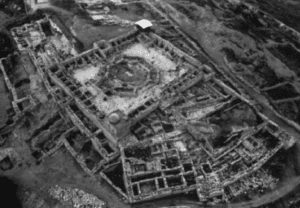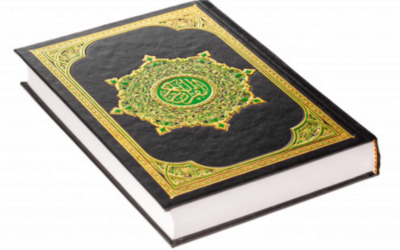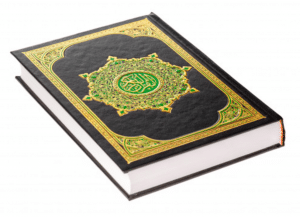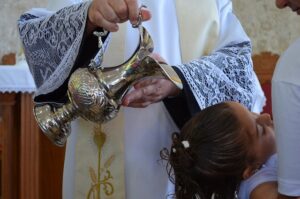The LDS (or Mormon) Church builds temples throughout the world, claiming that these buildings are a continuation of Biblical temple worship. Leaving aside, for the moment, the fact that temple worship is already fulfilled in Christ, having been an Old Covenant type and shadow pointing forward, there is another matter worth discussing. Even in the Old Testament, when God Himself established a temple, did God ever desire for there to be more than one temple to His name? Did God wish for many temples in various places? The biblical answer is a clear and resounding “no.”
The Law of Moses and the chosen place
Deuteronomy 12 explains that God will establish a chosen place for His temple. In contrast to the pagan Canaanites who “serve their gods on the high mountains and on the hills and under every green tree” (Deuteronomy 12:2), God tells Israel:
“You shall not act like this toward the Lord your God. But you shall seek the Lord at the place which the Lord your God will choose from all your tribes, to establish His name there for His dwelling, and there you shall come” (Deuteronomy 12:4-5).
God even speaks of a future time “When the Lord your God extends your border” and “the place which the Lord your God chooses to put His name is too far from you” (Deuteronomy 12:20-21). When that time comes, God allows certain activities to be done at home “in your gates” without having to travel to the Temple, but for “holy things,” they still must “go to the place which the Lord chooses.” Building more temples for people who live far away was not an option. This idea is repeated throughout the rest of Deuteronomy and is never negated in later Scripture.
The temple as God’s one chosen place
 Now, when Solomon built the Temple in Jerusalem, that was this singular place for God’s name, as Solomon said:
Now, when Solomon built the Temple in Jerusalem, that was this singular place for God’s name, as Solomon said:
“Now the Lord has fulfilled His word which He spoke; for I have risen in place of my father David and sit on the throne of Israel, as the Lord promised, and have built the house for the name of the Lord, the God of Israel,” (1 Kings 8:20).
This temple was not just the only place for sacrifices and holy ordinances, but even the direction to which the people were to pray:
“Listen to the supplication of Your servant and of Your people Israel, when they pray toward this place; hear in heaven Your dwelling place; hear and forgive” (1 Kings 8:30).
There was never any confusion as toward which temple one ought to pray. There were no other temples, nor should there ever be. Even as far away as Babylon and even after the temple building was destroyed, Daniel prayed toward that place, (Daniel 6:10). It was God’s one, singular, appointed place, the only true temple. And this was true not only for the Israelite but also for the distant foreigner:
“Also concerning the foreigner who is not of Your people Israel, when he comes from a far country for Your name’s sake (for they will hear of Your great name and Your mighty hand, and of Your outstretched arm); when he comes and prays toward this house, hear in heaven Your dwelling place, and do according to all for which the foreigner calls to You, in order that all the peoples of the earth may know Your name, to fear You, as do Your people Israel, and that they may know that this house which I have built is called by Your name,” (1 Kings 8:40-43).
The goal was not that the nations would have their own temples but that they would honor God’s name by praying toward and coming to the one temple in Jerusalem.
The divided kingdom and the single temple
After Solomon’s time, when the kingdom was divided into two (Israel and Judah), God made Jeroboam king of the northern nation. Jeroboam feared:
“If this people go up to offer sacrifices in the house of the Lord at Jerusalem, then the heart of this people will return to their lord, even to Rehoboam king of Judah; and they will kill me and return to Rehoboam king of Judah,” (1 Kings 12:27).
Jeroboam knew of no other true temple than the one in Jerusalem (and, we might note, no other reason for people to travel there than for sacrifices. He had no thoughts of them traveling to the temple for marriages, endowment ceremonies, baptisms for the dead, etc. Such rituals were unknown in God’s temple). But here is the key point. When we read Jeroboam’s story, it is conspicuous that He did not have the option to simply build more true temples in his own land for his own people. He had to either allow his people to travel to Jerusalem and worship the Lord in the land of Judah or else he must create a new religion. There was no third option. Tragically, he chose the latter and, even though he claimed that the god worshiped in his temples was the God who “brought you out of the land of Egypt” (1 Kings 12:28), this was not so, and he led Israel into great sin.
The Jews, the Samaritans, and the one chosen place
 Similarly, in the time of the New Testament, you had two groups of people who worshipped the God of Israel and honored the law of Moses: the Jews and the Samaritans. The Jews knew that God had chosen Jerusalem as “the place which the Lord your God chooses to put His name,” to use the words of that law. The Samaritans, however, believed that God had chosen Mount Gerizim and that the true temple should stand there. Jesus taught that, after His coming, neither location was needed any longer. Temple worship was fulfilled, and true worshippers now worship in spirit and truth rather than in temples of stone (see John 4:19-24). For our purposes, however, what is noteworthy here is that both sides understood that the Scriptures made it clear that there could not be two temples. Even under the Old Testament system of God’s established temple worship, there could only be one temple. Anyone reading Deuteronomy knew that it had to be Jerusalem or Mount Gerizim; it could not be both. There were not two chosen places for temples in God’s name. There was only to be one.
Similarly, in the time of the New Testament, you had two groups of people who worshipped the God of Israel and honored the law of Moses: the Jews and the Samaritans. The Jews knew that God had chosen Jerusalem as “the place which the Lord your God chooses to put His name,” to use the words of that law. The Samaritans, however, believed that God had chosen Mount Gerizim and that the true temple should stand there. Jesus taught that, after His coming, neither location was needed any longer. Temple worship was fulfilled, and true worshippers now worship in spirit and truth rather than in temples of stone (see John 4:19-24). For our purposes, however, what is noteworthy here is that both sides understood that the Scriptures made it clear that there could not be two temples. Even under the Old Testament system of God’s established temple worship, there could only be one temple. Anyone reading Deuteronomy knew that it had to be Jerusalem or Mount Gerizim; it could not be both. There were not two chosen places for temples in God’s name. There was only to be one.
Conclusion: There was only ever supposed to be one temple
From Sinai down to the coming of Christ, for the entire period in which God sanctioned temple worship, He made it clear to all that only one temple was permitted. Making temples in every place was the way of the Canaanite pagans, and God rejected it. No matter how far one lived from the one temple, they were to travel to it. It was even the direction to which people were to pray. There was only one chosen place, only ever to be one proper temple at any given time. The Jews knew it. The Samaritans knew it. Even wicked Jeroboam knew it. God never desired the building of many temples.






